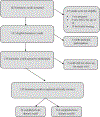Unaccompanied homeless youth have extremely poor diet quality and nutritional status
- PMID: 31485095
- PMCID: PMC6724733
- DOI: 10.1080/02673843.2018.1538885
Unaccompanied homeless youth have extremely poor diet quality and nutritional status
Abstract
A lack of in-depth assessment of the nutritional status of homeless youth precludes interventions that achieve nutritional adequacy. We enrolled 118 unaccompanied homeless youth to obtain sociodemographic and health data along with dietary, anthropometric, biochemical, and clinical assessments. As a reference, homeless youth data were compared to a convenience sample of 145 college students. Obesity was prevalent among homeless youth than among college students (29% vs. 8% respectively (CI: 11.2, 29.9). Among homeless youth, 74% of females versus 41% of males were overweight/obese (CI: 14.9, 51.2). Homeless youth also had poor diet quality (44.37 (SD: 12.64)). Over 70% of homeless youth had inadequate intakes of vitamins A, C, D3 and E, as well as calcium and magnesium. Our findings show increased weight, adiposity, and suboptimal intakes of essential nutrients among unaccompanied homeless youth. Further studies are needed to inform evidence-based nutrition interventions that will aid in improving their nutritional health.
Keywords: Unaccompanied youth; diet quality; homeless; nutritional status.
Conflict of interest statement
Disclosure statement No potential conflict of interest was reported by the authors.
Figures
Similar articles
-
Homeless youth in Toronto are nutritionally vulnerable.J Nutr. 2005 Aug;135(8):1926-33. doi: 10.1093/jn/135.8.1926. J Nutr. 2005. PMID: 16046718
-
Adequacy of nutritional intake during pregnancy in relation to prepregnancy BMI: results from the 3D Cohort Study.Br J Nutr. 2018 Aug;120(3):335-344. doi: 10.1017/S0007114518001393. Epub 2018 Jun 7. Br J Nutr. 2018. PMID: 29875026
-
Assessment of nutrient adequacy with supplement use in a sample of healthy college students.J Am Coll Nutr. 2012 Oct;31(5):301-10. doi: 10.1080/07315724.2012.10720424. J Am Coll Nutr. 2012. PMID: 23529987
-
A Historical Review of Changes in Nutrition Standards of USDA Child Meal Programs Relative to Research Findings on the Nutritional Adequacy of Program Meals and the Diet and Nutritional Health of Participants: Implications for Future Research and the Summer Food Service Program.Nutrients. 2015 Dec 4;7(12):10145-67. doi: 10.3390/nu7125523. Nutrients. 2015. PMID: 26690207 Free PMC article. Review.
-
Assessing the effectiveness of nutrition interventions implemented among US college students to promote healthy behaviors: A systematic review.Nutr Health. 2018 Sep;24(3):171-181. doi: 10.1177/0260106018785528. Epub 2018 Jul 17. Nutr Health. 2018. PMID: 30014743
Cited by
-
Mental health in society's margins: poor n-3 PUFA intake and psychological well-being of homeless youth.Br J Nutr. 2024 Feb 28;131(4):698-706. doi: 10.1017/S000711452300212X. Epub 2023 Sep 22. Br J Nutr. 2024. PMID: 37737219 Free PMC article.
-
Material hardship, forced displacement, and negative health outcomes among unhoused people who use drugs in Los Angeles, California and Denver, Colorado: a latent class analysis.BMC Public Health. 2025 Feb 13;25(1):591. doi: 10.1186/s12889-025-21626-6. BMC Public Health. 2025. PMID: 39939965 Free PMC article.
-
Double burden of malnutrition amongst patients with first-episode schizophrenia in a psychiatric hospital: A 1-year follow-up study.S Afr J Psychiatr. 2020 Nov 10;26:1564. doi: 10.4102/sajpsychiatry.v26i0.1564. eCollection 2020. S Afr J Psychiatr. 2020. PMID: 33240554 Free PMC article.
-
Material Hardship, Forced Displacement, and Negative Health Outcomes Among Unhoused People Who Use Drugs in Los Angeles, California and Denver, Colorado: A Latent Class Analysis.Res Sq [Preprint]. 2024 Dec 18:rs.3.rs-5221742. doi: 10.21203/rs.3.rs-5221742/v1. Res Sq. 2024. Update in: BMC Public Health. 2025 Feb 13;25(1):591. doi: 10.1186/s12889-025-21626-6. PMID: 39764118 Free PMC article. Updated. Preprint.
-
Diet Quality, Health, and Wellbeing within the Irish Homeless Sector: A Qualitative Exploration.Int J Environ Res Public Health. 2022 Nov 30;19(23):15976. doi: 10.3390/ijerph192315976. Int J Environ Res Public Health. 2022. PMID: 36498047 Free PMC article.
References
-
- Basiotis P, Carlson A, Gerrior S, Juan W, & Lino M (2002). The healthy eating index, 1999–2000. Alexandria, VA: U.S. Department of Agriculture, Center for Nutrition Policy and Promotion.
Grants and funding
LinkOut - more resources
Full Text Sources
Research Materials

